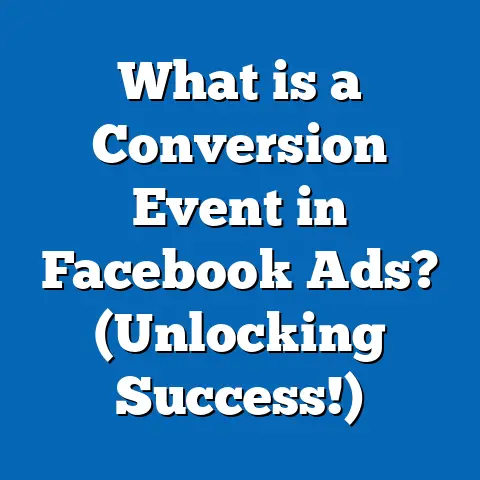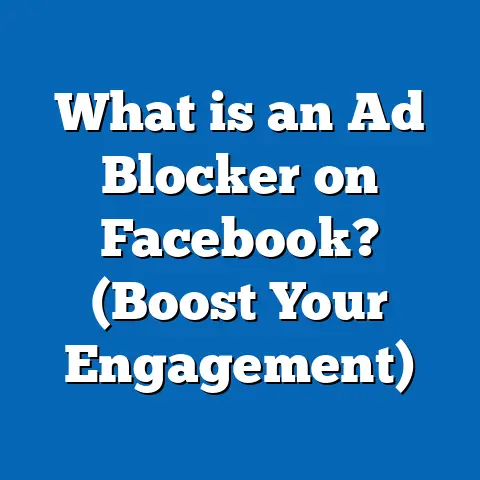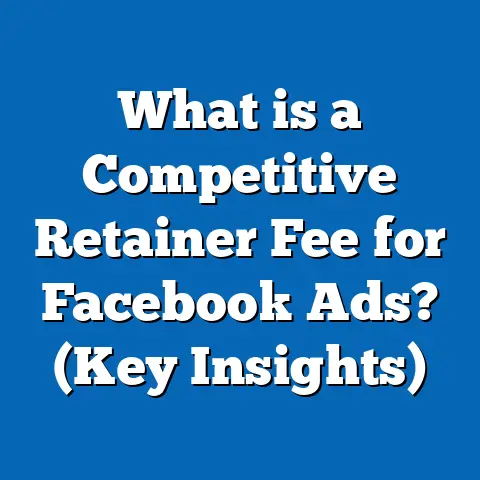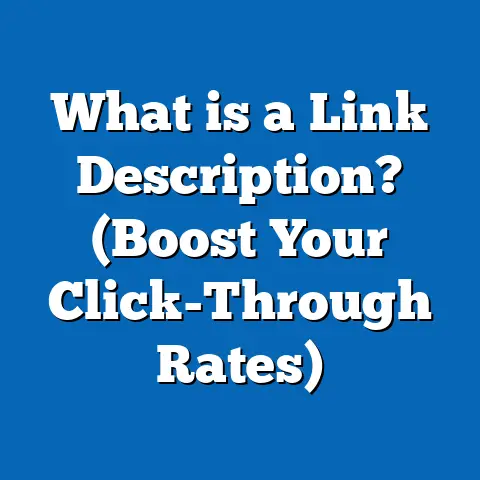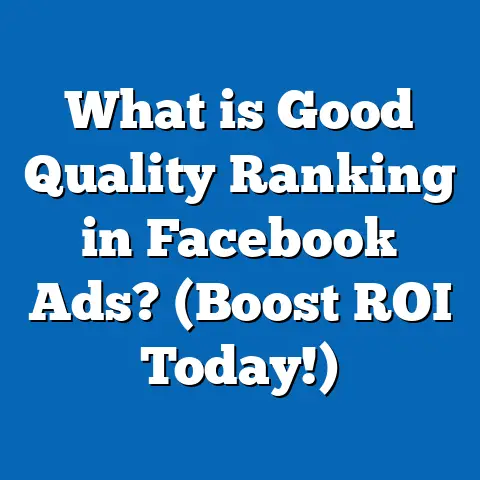What is Bid Strategy in Facebook Ads? (Unlocking Ad Success)
What is Bid Strategy in Facebook Ads? (Unlocking Ad Success)
Introduction: The Irony of Choice in Facebook Ads
If only advertising on Facebook was as simple as clicking “Boost Post” and watching sales skyrocket. The irony is that with so many options, marketers often feel paralyzed rather than empowered. Facebook offers a plethora of targeting tools, budget settings, and importantly, bid strategies. Yet, many advertisers treat bid strategy as an afterthought, unaware it can make or break their campaigns. Understanding bid strategy is not just a technical detail—it is the key to unlocking efficient ad spend and maximizing return on investment (ROI).
Understanding Bid Strategy in Facebook Ads
What is a Bid Strategy?
In Facebook advertising, a bid strategy refers to the approach you take to tell Facebook how much you are willing to pay for your desired outcome—whether it’s clicks, impressions, conversions, or app installs. Essentially, it’s the way you control your ad spending to achieve your marketing goals within your budget.
Facebook’s ad delivery system uses an auction model where advertisers compete to show their ads to the right audience. Your bid is your offer to win that auction. However, it’s not just about bidding the highest; Facebook’s algorithm balances bid amount with ad quality and relevance to decide which ads win.
Why Bid Strategy Matters
- Cost Efficiency: Choosing the wrong bid strategy can lead to overspending or under-delivery.
- Campaign Goals Alignment: Different goals require different bidding approaches.
- Maximizing Results: Optimized bidding can improve key metrics like Cost Per Acquisition (CPA), Return on Ad Spend (ROAS), and Click-Through Rate (CTR).
Key Terms to Know
- Bid: The maximum amount you’re willing to pay per desired action.
- Impression: When your ad is shown once.
- Click: A user clicking your ad.
- Conversion: A completed action such as purchase or signup.
- Cost Per Result: Average cost you pay for each outcome (click, conversion).
- Auction: The process where Facebook decides which ads to show based on bids and relevance.
How Facebook Ad Auctions Work: The Foundation of Bid Strategy
To understand bid strategies, you need to understand how Facebook’s ad auction operates.
The Auction Process
- Advertisers enter bids based on their chosen strategy.
- Facebook calculates a total value for each ad considering:
- Bid amount
- Estimated action rates (likelihood of achieving the goal)
- Ad quality and relevance score
- The highest total value wins the auction, and that ad is shown.
This means simply bidding more does not guarantee winning if your ad relevance is low.
Data-Backed Insight: Auction Winners and Costs
According to Facebook’s own data:
- Advertisers who optimize their bid strategy have seen up to a 20% reduction in CPA.
- Ads with higher relevance scores (8-10) tend to cost 30-50% less per conversion than lower-scoring ads.
Types of Bid Strategies on Facebook
Facebook offers several bidding options designed to match different advertiser goals:
1. Lowest Cost (Auto Bid)
- What it is: Facebook automatically sets bids to get the most results at the lowest cost.
- When to use: If you want simplicity and automatic optimization.
- Pros: Easy setup; good for broad campaigns.
- Cons: Less control over cost per action; can sometimes overspend.
2. Cost Cap
- What it is: You set a maximum average cost per result you’re willing to pay.
- When to use: When controlling cost per conversion is critical.
- Pros: Helps keep costs predictable while maximizing volume.
- Cons: May limit delivery if the cap is too low.
3. Bid Cap
- What it is: You set a hard maximum bid Facebook cannot exceed.
- When to use: When strict cost control per auction is needed.
- Pros: Precise cost management.
- Cons: May reduce total results due to limited bidding flexibility.
4. Target Cost (Legacy)
- What it was: Facebook aimed for consistent costs per result over time.
- Note: This option is being phased out in favor of Cost Cap.
5. Manual Bidding (Less Common Now)
Advertisers set bids manually for each auction. Rarely used now due to complexity and better automatic options.
Choosing the Right Bid Strategy Based on Campaign Objectives
| Campaign Goal | Recommended Bid Strategy | Reason |
|---|---|---|
| Brand Awareness / Reach | Lowest Cost | Maximize exposure with minimal manual effort |
| Lead Generation | Cost Cap | Control cost per lead while maximizing volume |
| App Installs | Cost Cap / Lowest Cost | Balance cost and installs |
| Conversion/Sales | Cost Cap / Bid Cap | Keep acquisition costs profitable |
| Retargeting | Lowest Cost / Cost Cap | Efficiently re-engage interested audiences |
Advanced Insights: How Bid Strategies Affect Performance Metrics
Impact on Cost Per Acquisition (CPA)
Case Study: A mid-sized e-commerce brand switched from Lowest Cost to Cost Cap bidding and saw CPA drop by 15% over three months while maintaining consistent sales volume.
Effect on Return on Ad Spend (ROAS)
Data from WordStream shows advertisers who use Cost Cap bidding report up to 18% higher ROAS compared to those using Lowest Cost.
Delivery Volume vs. Cost Control Trade-off
Bid Cap strategies can restrict ad delivery if bids are too low, potentially missing opportunities during peak demand periods.
Practical Tips for Implementing Bid Strategies in Facebook Ads
- Start with Lowest Cost for testing — gather data before switching strategies.
- Use Cost Cap when you have clear ROI targets — it provides balance between volume and cost control.
- Avoid setting bid caps too low — this can throttle delivery.
- Monitor performance daily during early campaign phases.
- Adjust bids based on campaign phases — e.g., aggressive bids during launches, conservative bids during scaling.
- Combine with Audience Targeting — tighter audiences may need different bidding than broad ones.
Comparing Facebook Bid Strategies with Google Ads
| Feature | Facebook Ads | Google Ads |
|---|---|---|
| Auction Model | Total value based on bid + relevance | Primarily bid-based auction |
| Bid Options | Automated (Lowest Cost), Cost/Bid Cap | Manual CPC, Target CPA, Maximize Conversions |
| Control Level | High with advanced options | High but more manual control |
| Optimization Focus | Balances cost and relevance | Often focuses on keywords & intent |
Facebook’s bidding integrates ad quality more prominently, which can make bids more efficient if ads are relevant.
Latest Trends and Updates in Facebook Bidding (2024)
- Increased emphasis on machine learning for automatic bid optimization.
- Introduction of “Advantage Plus” campaigns that combine bidding and targeting automation.
- More granular controls for bid strategies in CAPI (Conversions API) setups.
- Enhanced reporting tools showing detailed bid performance metrics.
Deep Dive: How Facebook’s Algorithm Uses Bid Strategies
Facebook’s delivery system uses machine learning models trained on billions of impressions daily. It predicts how likely each individual user is to take the desired action based on past behavior and contextual signals.
How Bids Influence Auction Outcomes
The “total value” Facebook calculates includes: Total Value=Bid×Estimated Action Rate×Ad Quality Score\text{Total Value} = \text{Bid} \times \text{Estimated Action Rate} \times \text{Ad Quality Score}
Even if your bid is high, a low estimated action rate or poor ad quality can cause your ad not to win.
Optimizing Your Bid Strategy with Algorithm Insights
Understanding this formula helps marketers realize they should optimize both their bids and their ad creative/relevance simultaneously. A high-quality ad with a moderate bid often outperforms a low-quality ad with a high bid.
Case Studies: Real-World Examples of Bid Strategy Impact
Case Study 1: Retail Brand Boosts ROAS by 25% Switching to Cost Cap
A national retail brand running conversion-focused campaigns initially used Lowest Cost bidding but experienced fluctuating costs. Switching to Cost Cap allowed better control over CPA without sacrificing volume, increasing ROAS by 25% within two months.
Key Learnings:
- Set realistic cost caps based on historical data.
- Monitor delivery closely after switching.
- Use high-quality creatives to complement bidding strategy.
Case Study 2: SaaS Company Reduces CPA by 18% Using Bid Cap
A software-as-a-service company struggled with high CPA during peak seasons. By implementing Bid Cap bidding with data-informed caps, they reduced CPA by 18%, improved budget predictability, and maintained steady lead flow.
Key Learnings:
- Manual control allowed predictable spending during competitive periods.
- Integration with CRM data improved targeting precision.
Common Mistakes with Facebook Bid Strategies and How to Avoid Them
- Ignoring Campaign Goals When Choosing Bidding Type
Many advertisers pick Lowest Cost by default without aligning it with their objectives—this often leads to wasted budget or poor results.
- Setting Unrealistic Bid Caps or Cost Caps
Caps set too low choke delivery; set too high defeat purpose of cost control.
- Neglecting Ad Quality While Focusing Only on Bids
High bids won’t work effectively without relevant, engaging ads.
- Not Testing Different Bidding Strategies
Avoid sticking rigidly to one strategy; use A/B testing tools to find what works best.
- Failing to Adjust Based on Market Conditions
Bid strategies need adjustment during holidays, sales events, or industry shifts when competition changes.
Measuring Success: Metrics You Must Track With Different Bid Strategies
Tracking the right metrics helps evaluate if your bidding strategy works:
- Cost Per Result (CPA/CPL/CPI): Core metric showing efficiency.
- Return on Ad Spend (ROAS): Revenue generated per dollar spent.
- Click-Through Rate (CTR): Indicates ad engagement quality.
- Impression Share: Percentage of auctions you win out of total possible impressions.
- Frequency: How often users see your ad—too high can increase costs without benefit.
- Delivery Rate: Volume of impressions or conversions delivered versus target.
How Audience Targeting Interacts With Bid Strategies
Audience size and quality impact bid strategy success:
- Narrow audiences often require higher bids due to competition but yield better conversion rates.
- Broad audiences benefit from Lowest Cost bidding but may have higher CPA due to less precise targeting.
Combining bid strategies with layered audience segmentation improves efficiency significantly.
Using Automated Rules and Machine Learning to Optimize Bids
Facebook now supports automated rules where you can:
- Increase or decrease bids based on performance thresholds automatically.
- Pause ads if CPA exceeds target limits.
Machine learning-powered “Advantage Plus” campaigns automate bidding along with targeting, showing promising results for brands wanting hands-off management while maintaining efficiency.
Integrating Offline Data and Conversions API for Better Bidding Accuracy
Facebook’s Conversions API allows direct sharing of offline sales data back into Facebook’s system, improving event tracking accuracy. This data helps refine estimated action rates in auctions, thus making bid strategies more effective by giving better signals about user value.
Brands using offline data integration have reported:
- Up to 10% improvement in conversion tracking accuracy.
- Better optimization and bidding decisions leading to lower CPAs.
Step-by-Step Guide: Setting Up Bid Strategy in Facebook Ads Manager
- Create or Edit Campaign:
- Choose campaign objective aligned with goals (Conversions, Traffic, Lead Generation).
- At Ad Set Level, Find Budget & Schedule Section:
- Choose budget type: Daily or Lifetime budget.
- Scroll Down to Optimization & Delivery:
- Select “Optimization for Ad Delivery” goal (e.g., Conversions).
- Choose “Bid Strategy” from dropdown menu:
- Lowest Cost
- Cost Cap
- Bid Cap
- Enter your target cap if applicable.
- Set Your Audience Targeting & Placements
- Launch Campaign
- Monitor Performance Metrics Closely
- Adjust Bids or Caps Based on Early Data (typically after 3–5 days)
Frequently Asked Questions About Facebook Bid Strategy
Q1: Can I switch bid strategies mid-campaign?
Yes, but be cautious. Switching can reset learning phases and temporarily impact delivery.
Q2: How do I know if my bid cap is too low?
If your ads struggle to deliver or impressions drop drastically after applying a cap, it’s likely too restrictive.
Q3: Is Lowest Cost always cheaper?
Not necessarily; it often gets more volume but might result in higher average CPA compared to capped strategies that focus on cost control.
Q4: Should I use manual bidding?
Manual bidding requires experience and constant monitoring; automatic strategies are preferred for most advertisers today unless very specific control is needed.
Final Thoughts: Mastering Bid Strategy Unlocks Ad Success
Bid strategy in Facebook ads is far more than a simple budget setting; it’s an integral lever that impacts campaign efficiency, cost control, and overall ROI. By understanding how auctions work, aligning bid strategies with campaign goals, leveraging data insights, and continuously optimizing based on results, marketers can dramatically improve performance on the platform.
Remember these essentials:
- Start simple with Lowest Cost but evolve towards Cost or Bid Caps as you scale and collect data.
- Maintain excellent ad quality alongside bid optimization.
- Use Facebook’s automation tools wisely but keep human oversight.
- Test rigorously and monitor metrics daily for best results.
Facebook bidding isn’t just about spending money—it’s about spending smartly.


